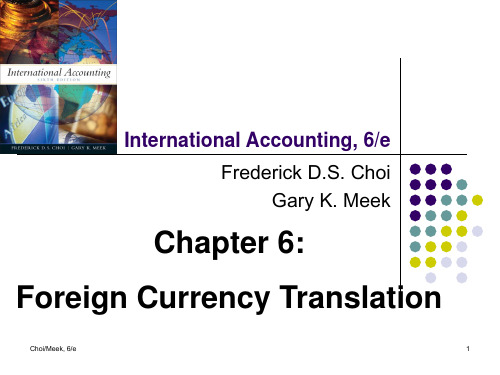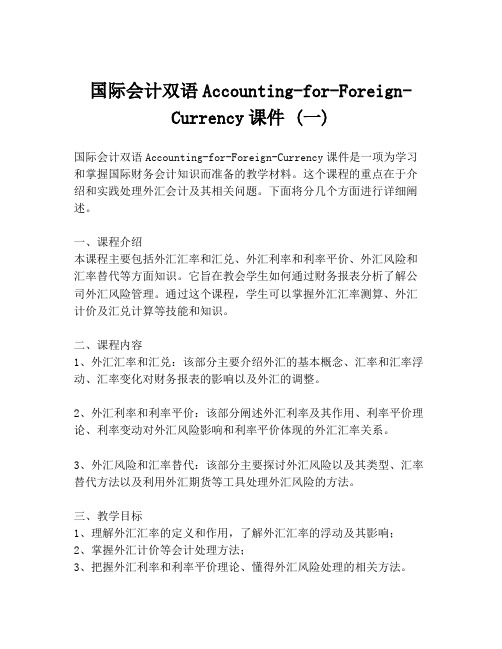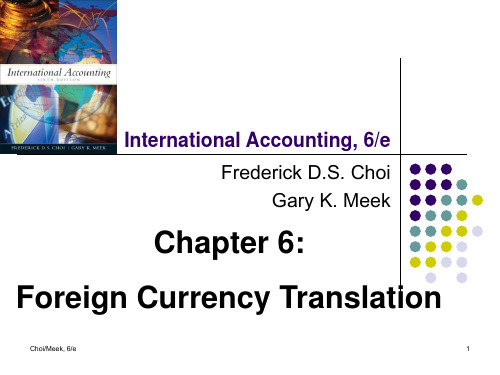国际会计学课件cha6 Foreign Currency Accounting
国际会计学第六版cha

Terminology 6.2 BANKGROUND AND TERMINOLOGY(P127-129)
• Conversio n
• Translation
• Act of exchanging • one type of
money • or security for • another
It is simply a change in monetary expression.
Spot & Foward exchange rate
Bid quote 买方出价
• Is what the foreign exchange dealer would pay you for foreign currency.
ask quote 卖方报价
• Is the rate at which the dealer would sell you foreign currency.
currency translation differ from the
current rate method? What is the relationship between
currency translation and inflation?
Why do Firms Translate? 〔P127〕
Types of Transaction Rates
Spot transactions: the physical exchange of one currency for another in which delivery takes place immediately. 〔P128〕
Factors:
Learning Objectives
国际会计学课件CHA6 Exercise

) method ,the consolidated statements
preserve the original financial statement relationships such as
• 14. (
• 15.Under(
) method views monetary assets and liabilities
e ( ) rate to translate statement items should give rise to translation gains and losses. 11. Exchange gains and losses can be divided two parts :( ) gains and losses and ( ) gains and losses.
• 8.There are four methods can be used in foreign currency translation. They are( ) method, ( ) method,( ) method and ( )method. e ( )rate to translate statement items should not give rise to translation gains or losses, so it can preserves the original cost equivalent of a foreign currency item in the reporting currency.
current rate.
• 16.A subsidiary company perspective requires the ( ) translation method in order to preserve relationship exiting in the foreign currency statements.
国际会计学第六版chapter_6-42页文档资料

Choi/Meek, 6/e
16
Choi/Meek, 6/e
17
Types of Translation Methods
Single rate method: applies a single exchange rate, the current rate, to all foreign currency assets and liabilities.
Choi/Meek, 6/e
2
How does a translation gain or loss differ from a transactions gain or loss?
Is there more than one way of translating financial statements from one currency to another? If so, what are they?
Preserves the original cost equivalent of a foreign currency item in the reporting currency.
Use of historical rates do not give rise to
translation gains or losses, which are
At the transaction date, each asset, liability, revenue, and expense denominated in a foreign currency is measured and recorded in the functional currency of the reporting entity at the spot exchange rate in effect on that date.
《国际会计学》课件

国际会计学的发展历程
19世纪末至20世纪初:国际会计学的萌芽阶段,主要关注会计准则和会计制度的制定
20世纪初至20世纪中叶:国际会计学的初步发展阶段,主要关注会计准则和会计制度的完善 20世纪中叶至20世纪末:国际会计学的快速发展阶段,主要关注会计准则和会计制度的国际化
21世纪初至今:国际会计学的成熟阶段,主要关注会计准则和会计制度的全球统一化
国际财务报告的改进方向和措施
提高财务报告的透明度和 准确性
加强内部控制和审计监督
采用国际会计准则和国际 财务报告准则
提高财务报告的时效性和 灵活性
加强信息披露和投资者关 系管理
提高财务报告的智能化和 自动化水平
国际会计学在企业中的应用和案例分析
国际会计准则的应用:介绍国际会计准则在企业中的应用,如财务报告、内部控制等方面。
国际财务报告准则(IFRS): 国际通用的财务报告标准
改进措施:加强内部控制、提 高信息披露质量、加强审计监
督
国际财务报告的质量现状和问题
问题一:信息披露不充分, 缺乏透明度
问题二:会计准则不一致, 导致可比性差
国际财务报告的质量现状: 存在一定的差异和不规范
问题三:审计质量参差不齐, 存在风险隐患
国际财务报表的编制基础和原则
国际会计准则(IAS):国际财务报表编制的基础 财务报表的构成:资产负债表、利润表、现金流量表等 财务报表的披露原则:透明度、可比性、完整性、及时性 财务报表的编制方法:历史成本法、公允价值法等
国际财务报表的构成和内容
利润表:反映企业在一定时 期的经营成果
现金流量表:反映企业在一定 时期的现金流入和流出情况
披露语言:使用国际通用的语言进行披 露,如英语、法语等
国际会计学第六版chapter_6 Foreign Currency Translation

Choi/Meek, 6/e
18
Choi/Meek, 6/e
19
Current-Noncurrent Method
Depreciation and amortization charges at
historical rates in effect when related
assets are acquired.
Gain or loss on an unsettled transaction: arises whenever consolidated financial statements are prepared before settlement and the current rate has changed since the transaction date.
At each balance sheet date, recorded balances denominated in a currency other than the functional currency of the reporting entity is adjusted to reflect the current exchange rate.
Choi/Meek, 6/e
2
How does a translation gain or loss differ from a transactions gain or loss?
Is there more than one way of translating financial statements from one currency to another? If so, what are they?
国际会计双语Accounting-for-Foreign-Currency课件 (一)

国际会计双语Accounting-for-Foreign-Currency课件 (一)国际会计双语Accounting-for-Foreign-Currency课件是一项为学习和掌握国际财务会计知识而准备的教学材料。
这个课程的重点在于介绍和实践处理外汇会计及其相关问题。
下面将分几个方面进行详细阐述。
一、课程介绍本课程主要包括外汇汇率和汇兑、外汇利率和利率平价、外汇风险和汇率替代等方面知识。
它旨在教会学生如何通过财务报表分析了解公司外汇风险管理。
通过这个课程,学生可以掌握外汇汇率测算、外汇计价及汇兑计算等技能和知识。
二、课程内容1、外汇汇率和汇兑:该部分主要介绍外汇的基本概念、汇率和汇率浮动、汇率变化对财务报表的影响以及外汇的调整。
2、外汇利率和利率平价:该部分阐述外汇利率及其作用、利率平价理论、利率变动对外汇风险影响和利率平价体现的外汇汇率关系。
3、外汇风险和汇率替代:该部分主要探讨外汇风险以及其类型、汇率替代方法以及利用外汇期货等工具处理外汇风险的方法。
三、教学目标1、理解外汇汇率的定义和作用,了解外汇汇率的浮动及其影响;2、掌握外汇计价等会计处理方法;3、把握外汇利率和利率平价理论、懂得外汇风险处理的相关方法。
四、教材特点本教材是以资产负债表、利润表为重心,从外汇会计开展上介绍和分析财务报表,并带有双语翻译。
五、教学难点汇率的计算、外汇风险的控制和外汇会计处理是本课程的难点部分,需要学生进行每周的习题和课堂练习。
六、教学方法本课程主要采用讲授、实例分析、案例研究和互动讨论等多种教学方法,充分发挥师生互动,促进课程教学的有效展开。
七、教学评价本课程视力、听力、口语、写作和算法技能的等级评价。
除了学术表现之外,表现优秀的学生还将有机会获得实习机会等奖励。
通过考核,学生成绩优秀者还将有机会赴海外进行进一步学习和深造。
总之,国际会计双语Accounting-for-Foreign-Currency课件,是培养掌握国际财务知识和提高学生在外汇会计方面的实际能力的重要手段。
国际会计学第六版chapter_6Foreign Currency Translation教学讲义

What exchange rates are used in the currency translation process and what are their financial statement effects?
At the transaction date, each asset, liability, revenue, and expense denominated in a foreign currency is measured and recorded in the functional currency of the reporting entity at the spot exchange rate in effect on that date.
Facilitates repoeign audiences-of-interest.
Choi/Meek, 6/e
5
Types of Transaction Rates
Spot transactions: the physical exchange of one currency for another in which delivery takes place immediately.
Swap transaction: involves the simultaneous spot purchase and forward sale, or spot sale and forward purchase of a currency.
Choi/Meek, 6/e
7
国际会计学(上)教学精品PPT课件

第一节 影响会计模式的会计环境
会计环境,是指会计所面临的条件和情况。
会计环境是一个内容十分广泛的命题,是导致不同会计模式和不 同国家会计差异的主要原因。
主要包括:政治因素、经济因素、法律因素和文化因素等。
课后阅读:美国著名国际会计学者弗雷德里克、乔伊等的八因素论
(2)国际金融市场逐步形成;
三大金融市场:伦敦、纽约和东京
(3)国内企业纷纷走向国际货币资本市场融资。
(二)跨国公司的兴起
——跨国公司(Transnational Corporation):至少在两个国家进行制
造、销售和服务活动的公司。
跨国公司具有两面性:一方面具有垄断性和国际剥削性(超越多数国家 法律、强势战略),另一方面它作为世界性的企业组织形式具有科学性 和合理性(高效率的经营活动、输送知识和技能)。
2、我国学者徐经长等所下的定义 国际会计:现代会计在国际范围内的拓展,它与 国别会计比较、国际会计差异协调及跨国经营所 涉及的财务会计和管理会计问题为对象,以协调 差异和加强跨国经营会计管理为目标的一个新的 会计分支(徐经长、杜胜利、陈轲,1999)。
二、国际会计的形成和发展的原因
将国际会计作为一个专题研究始于20世纪六十年 代,但会计的国际化过程却自会计产生起就存在。直 接推动国际会计(作为一门独立的学科)产生的原因 如下:
(三)经济地区化的推进
——主要表现为区域经济集团的形成,如欧洲联盟(UN)、 经济合作与发展组织(OECD)等。
(四)国际间财务会计的交流
——主要通过会计国际组织或区域组织来进行 如:欧洲会计师联合会、国际会计合作委员会、会计职业国际协调 委员会、国际会计准则委员会、国际会计师联合会等。
- 1、下载文档前请自行甄别文档内容的完整性,平台不提供额外的编辑、内容补充、找答案等附加服务。
- 2、"仅部分预览"的文档,不可在线预览部分如存在完整性等问题,可反馈申请退款(可完整预览的文档不适用该条件!)。
- 3、如文档侵犯您的权益,请联系客服反馈,我们会尽快为您处理(人工客服工作时间:9:00-18:30)。
• To record foreign currency tranctions.
• The expanded scale of international investment increases the need to transfer accounting information from one country to users in others.
• *6.Foreign currency . • A currency other than the currency of the country being referred to; A currency other than the reporting currency of the enterprise being referred to. • 外币:特定国家的非本国货币;特定企业的非报告货 币. • *7.Foreign currency financial statement. Financial statement that employ foreign currency as the unit of measure. • 外币财务报表:以外币作为计量单位的财务报表.
• 2.Indirect exchange rate (quote) • (Receivable Quote 应收法) • It is the reciprocal(倒数)of the direct quote, the price of a unit of domestic currency in terms of the foreign currency. It would take approximately 0.1639 U.S dollar to acquire 1 Chinese yuan .
• 3.current rate:
• The exchange rate in effect at the
relevant financial statement date.
•
现行汇率:相关财务报表日的实际汇率.
• 4.discount. • When the forward exchange rate is below the current spot rate • 折价:远期汇率低于即期现行汇率的差异.
Glossary of foreign currency translation terms • 1.attribute. • The quantifiable characteristic of an item that is measured for accounting purposes. For example, historical cost and replacement cost are attributes of an assets. • 计量属性:某一项目在会计计量中的可计量特征.例如 ,历史成本和重置成本就是资产的计量属性. • *2.conversion. • The exchange of one currency for another. • 兑换:一种货币与另一种货币的交换.
• On the contrary, assume the quote was $0.1195= ¥1 yesterday
but is $0.1200= ¥1 , is the Chinese yuan appreciation or depreciation?
• Appreciation
• (间接标价法下价格增加意味着本国货币的升值)
• Example: Suppose that the cash balance of a Chinese subsidiary located in America, on June 30 is $1000,000.The direct exchange rate on that date is $1=¥6.10, the U.S dollar
• (¥1 = USD 0.1639 )
Foreign Currency quote method
• Question:
• If the quote was USD1=¥6.10 yesterday, and it is
$1=¥6.20today? Is the Chinese yuan appreciation or depreciation? • Depreciation • (直接标价法下价格增加意味着本国货币的贬值)
• *8.Foreign currency translation. • Transactions (for example ,sales or purchases of goods or services or loans payable or receivable) whose terms are stated in a currency other than the entity’s functional currency. • 外币折算:用企业功能货币以外的货币表述的 交易.(例如,销售\购买货物\劳务或者应付\应 收款等.
BACKGROUND AND TERMINOLORY • Foreign Currency Market Price Method • Direct or Indirect quote. P169 • 1. Direct exchange rate method (Direct Quote)
• ( Payable Quote应付报价法)
•
Translation of foreign currency balance is straightforward
with either direct or indirect quotes. Domestic currency equivalents(等值) are obtained by multiplying foreign currency balances by direct exchange rate quotations or dividing foreign currency balances by indicurrency transaction accounting
•
REASONS FOR TRANSLATION p168
• Translation is the process of restating (重新表述)financial statement information from one currency to another. The reasons for translation includes: • A company with overseas operations should prepare consolidated
• Merchandise Inventory/ Purchases
• Accounts Payable
• Accounts Receivable
• Sales revenues
• Cash • Cost of Goods Sold • (Foreign) Exchange loss • (Foreign) Exchange gain • Exchange Gains or Losses • Deferred Exchange Gains
• *5.exposed net asset position. • The excess of assets that are measured or denominated in foreign currency and translated at the current rate over liabilities that are measured or denominated in foreign currency and translated at the current rate. • 受险净资产:用外币计量或标价并按照现行 汇率折算的资产,超过用外币计量或标价并 按照现行汇率折算的负债的差额.
equivalents of the Chinese yuan cash balance on June 30 is
¥6,100,000. • $1000,000x ¥6.10 = ¥6,100,000 (direct quote)
•
$1000,000÷ $0.1639= ¥6,100,000 (indirect quote)
4. Single-transaction Perspective VS. Twotransaction Perspective
5.The concept exchange gains and losses and its main contents. 6.Four foreign currency translation methods.
• Deferred Exchange Losses
• • • • • • • • • • • •
Attribute Current rate Foreign currency Functional currency Historical rate Monetary items Transaction gains and losses Translation gains and losses Current rate method Current-noncurrent method Monetary-nonmonetary method Temporal method
• In a direct quote, the exchange rate specifies the number of domestic currency units needed to acquire a unit of foreign
currency.
• For example, on a given day, the U.S dollar price of a Chinese yuan might be 6.10 in China. (USD1=¥6.10) • *The majority countries in the world use the direct quote except British and America .
